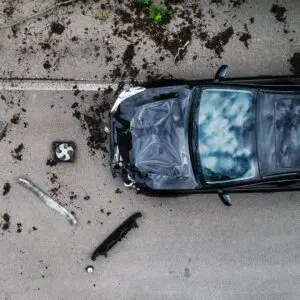How does comparative negligence work in PA car accidents?
How does comparative negligence work in PA car accidents? In Pennsylvania, it means your financial recovery depends on your share of fault compared to the other driver. If you are less than 51% responsible, you can still seek damages, but your percentage of blame reduces the amount.
Your Pennsylvania car accident lawyer at Munley Law can explain how these rules apply to your crash and what evidence matters most for protecting your claim.
What Is Comparative Negligence?
In Pennsylvania, comparative negligence is a rule that determines how to allocate blame and compensation when more than one person shares fault for a crash. Instead of placing all the blame on one driver, it allows the responsibility to be divided based on what each person did or failed to do. This model allows you to collect compensation, even if you hold some responsibility for the accident.
In Pennsylvania car accidents, this rule recognizes that real-world crashes rarely have a single cause. A driver may have been speeding, while the other may have failed to signal a turn. Comparative negligence assigns a percentage of fault to each party, allowing compensation to reflect the specific circumstances.
Some states follow pure comparative negligence models, which allow you to recover compensation, even if you are 99% at fault for the accident. However, the Commonwealth of Pennsylvania only allows you to collect compensation if you fall below a certain fault threshold. Falling below that limit keeps your claim alive, while crossing it can bar recovery entirely.
This system encourages fairness by weighing everyone’s actions instead of treating one mistake as the whole story, but it also makes it critical to seek legal representation to protect you from unfair liability.
How the Rules of Comparative Negligence Apply in Pennsylvania Car Accident Cases

Comparative negligence should be a consideration in every personal injury case. Very few occurances are black and white in terms of fault and responsibility. Judges and juries will review the evidence to determine what happened at the time of the crash. They will then work to apportion responsibility accordingly. Instead of treating an accident as one driver’s mistake, the rule recognizes that multiple factors can play a part. Courts and insurers often use this approach to decide how much fault to assign and how damages should be adjusted. Here are some of the ways this plays out in practice:
-
Responsibility is broken down into percentages by insurers and judges reviewing the case
-
The money awarded to you is lowered by the same percentage of fault placed on you
-
If a lawsuit goes to trial, jurors often decide how fault is divided
-
Details like photos, skid marks, police notes, and witness accounts are key pieces of evidence
-
Insurance adjusters may try to push more blame onto you to reduce what they owe
-
Judges oversee trials to confirm that the law is applied correctly
-
You may be eligible to file an appeal if you feel the determination was unjust
These rules play a major part in determining what an injured driver can expect after a crash. The percentages assigned to each side directly influence the financial outcome, which makes evidence and testimony vital at every stage. By setting clear guidelines on how responsibility is divided, Pennsylvania law helps establish consistency in accident claims.
Why Comparative Negligence Matters in Serious Injury Cases
Severe crashes often create long-lasting consequences. They can disrupt your ability to earn a living or to manage basic tasks without help. When losses reach this level, the way the fault is divided can decide whether you receive full compensation or only part of it. Your catastrophic injury lawyer can explain how these rules apply when the stakes are especially high.
Comparative Negligence in Catastrophic Injury Claims
When an accident results in a permanent disability, the costs of treatment and time away from work can reach millions of dollars. Even in these situations, comparative negligence still applies. If a jury decides you were partly responsible, comparative negligence rules require your recovery to reflect that share of fault. This reduction can change the amount you receive for long-term care and medically necessary home adjustments.
Comparative Negligence in Pedestrian and Cyclist Accidents
Collisions involving pedestrians or cyclists often lead to devastating injuries because there is little protection from the impact. Even so, comparative negligence can reduce the recovery if the injured person is found partially at fault. For example, crossing outside of a marked crosswalk or riding without proper lighting can become part of the fault calculation.
Evidence like traffic camera footage, witness statements, and accident reconstruction may clarify what really happened. The Commonwealth of Pennsylvania allows drivers to argue that a pedestrian or cyclist shared responsibility, but careful documentation can prevent unfair blame. When fault percentages are kept low, you are able to protect your financial recovery to meet your medical and long-term care needs.
Comparative Negligence in Multi-Vehicle Collisions
Chain reaction crashes create complicated fault questions because several drivers may have contributed to the accident. One car might have been following too closely, while another failed to brake in time. In a pileup, percentages of responsibility are spread across the group of drivers, which can lower the amount you receive if too much blame is placed on you.
Our personal injury lawyers know that these cases demand careful review of skid marks, dash cam footage, and police reports. Pennsylvania law, including 75 Pa. C.S.A. § 3361 requires drivers to maintain a safe speed for road conditions. In multi-vehicle collisions, showing that other drivers failed to drive according to conditions, even if that is below the posted speed limit, can reduce your share of fault and preserve more of your recovery.
The Rule of Modified Comparative Negligence
 Pennsylvania follows the modified comparative negligence model. This law means you can only recover damages if you are half or less than half responsible for a crash. This rule is significant because even a small change in fault percentages can decide whether a claim is valid. It draws a clear line between reduced recovery and no recovery at all, which makes fault determinations especially important in these cases.
Pennsylvania follows the modified comparative negligence model. This law means you can only recover damages if you are half or less than half responsible for a crash. This rule is significant because even a small change in fault percentages can decide whether a claim is valid. It draws a clear line between reduced recovery and no recovery at all, which makes fault determinations especially important in these cases.
This 50% threshold acts as the dividing line for accident claims in Pennsylvania. If you fall at or below 50%, damages are reduced in proportion to your share of fault. If you reach or exceed 51%, you are not longer elibilge to recover compensation from the other party. This is a rule that stays front of mind for insurance adjusters. They will make incredible efforts to give you as much liability as possible to push you over that threshold and get the claim dropped.
Determining Fault in a PA Car Accident Case
Jurors or insurance adjusters review the relevant evidence to assign fault percentages. Testimony from police officers and photos of the crash scene often carry significant weight in this decision. Input from accident reconstruction experts may also influence the apportionment of responsibility. Some of the common points of liability that we often see in PA car accident cases include:
-
All drivers
-
Local governments and municipalities
-
Pedestrians
-
Maintenance workers
Anyone who may have contributed to the accident can be considered when we investigate the circumstances of the case to determine liability. If you make the argument that someone should be responsible, but
The Significance of Evidence in Comparative Negligence Disputes
Not every accident leaves behind a perfect record of what happened. When reports are incomplete or evidence goes missing, deciding fault becomes less certain. In these situations, the way comparative negligence is applied depends heavily on how each side presents its version of events.
We may call on professionals to help fill those gaps, such as specialists who study traffic patterns or analyze vehicle damage. Crash records, medical opinions, and testimony from specialists may protect you from assuming unnecessary fault. This information can provide decision-makers with clearer picture when the available evidence leaves too many questions. When evidence is uncertain, this kind of testimony helps keep fault percentages tied to the facts instead of the defense’s speculation.
The comparative negligence model is one reason why evidence is so key in personal injury claims. In many cases, the amount of fault you assume can be just as important as the total damages you request. Establishing someone else’s negligence is an important step to ensuring you you not accept undue responsibility.
Comparative Negligence in Car Accident Cases
If you find yourself in a dispute regarding accident liability, the process of dividing fault is guided by both evidence and Pennsylvania law. Every detail, whether it is skid marks, eyewitness accounts, or photos, can influence how much responsibility is assigned to each driver.
A Pennsylvania personal injury lawyer can explain how these rules may apply to your case and help you prepare your evidence accordingly.
Your Percentage of Fault Will Reduce the Compensation You Receive
Once the Insurance company or courts determine how much responsibility everyone holds, they adjust the final payout in proportion to the responsibility assigned to you.
For example, if your damages are valued at $100,000 but you are found 20% responsible, you would recover $80,000. However, remember that If your responsibility exceeds 50%, Pennsylvania law blocks financial recovery altogether.
A Pennsylvania truck accident lawyer can support a factual evaluation, rather than one that reflects a one-sided arguments from insurers.
Get Help From Your Pennsylvania Car Accident Lawyer Today
Comparative negligence can make accident cases confusing, and it helps to have someone who knows how the rules actually play out. At Munley Law, we have years of experience taking on fault disputes and know how to handle the challenges that come with them. When questions about percentages and liability arise, your Pennsylvania car accident lawyer will be there to protect your claim and keep the process moving in your favor.
Acting sooner gives you more time to protect your rights while the evidence is still fresh and deadlines are still open. Your car accident attorney in Pennsylvania at Munley Law can look at the crash report and explain what our findings may mean for your claim. If you are wondering what these rules mean for you and your case, contact us today to discuss your situation and learn about your options.
Posted in Car Accidents, Munley News.









